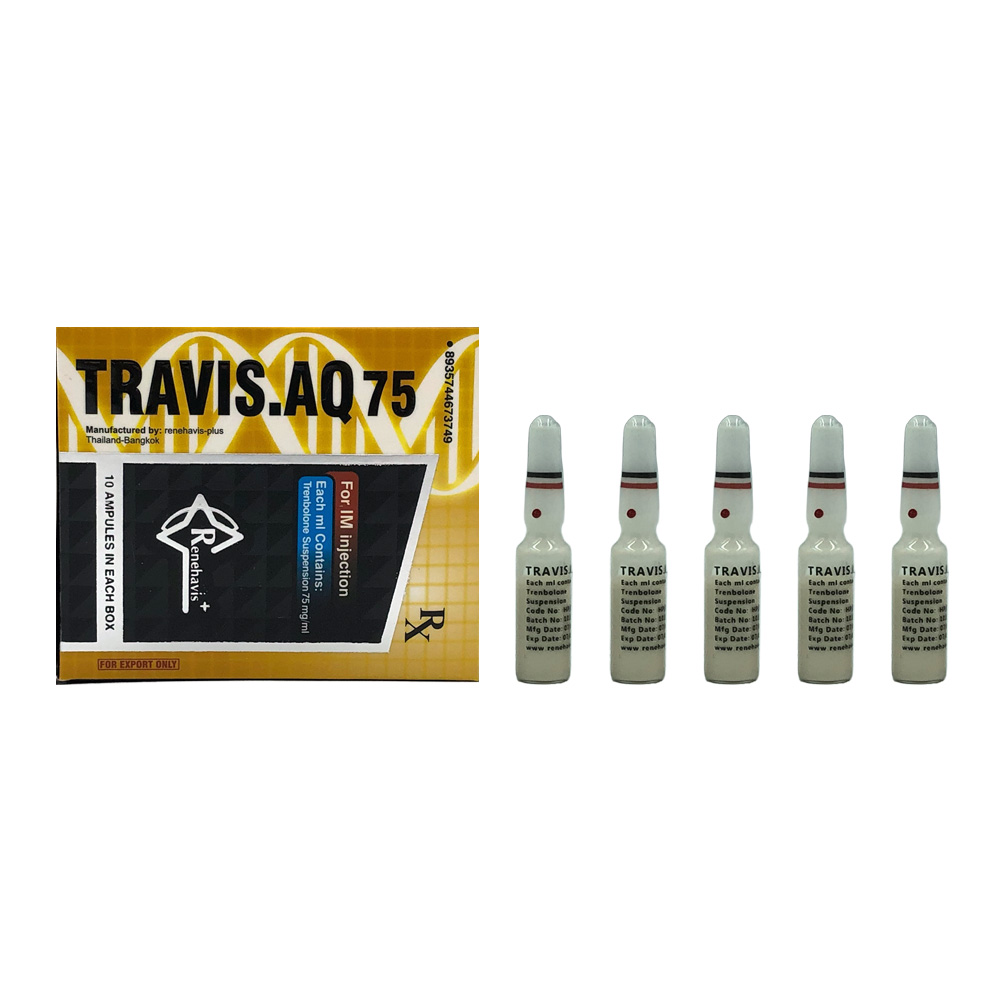
DESCRIPTION
TESTAVIS.AQ 75 is an aqueous suspension of ultra-micronized
un-esterified testosterone
base for IM administration suitable only when extremely
rapid increases in serum
testosterone are required. Serum response varies widely with
depth and location of IM
injection and characteristics of the suspension. Serum
testosterone levels will increase
within 1 hour of IM administration often peaking in less
than 6 hours with subsequent
clearance varying widely from 18 – 36 hours thereafter.
TESTAVIS.AQ 75 is rarely used for
replacement therapy as frequent injections are required.
Testosterone aqueous suspension
produces significant short-term increases in strength,
endurance, aggression and in many
cases libido.
INDICATIONS
Males: TESTAVIS.AQ 75 Injection is indicated only when an
extremely rapid elevation of
serum testosterone levels is clinically desirable on the
advice of a physician.
CLINICAL PHARMACOLOGY
Testosterone and dihydrotestosterone are responsible for
normal growth and development
of the male sex organs and for maintenance of secondary sex
characteristics. These effects
include the growth and maturation of the prostate, seminal
vesicles, penis, and scrotum; the
development of male hair distribution, such as facial,
pubic, chest, and axillary hair;
laryngeal enlargement; vocal cord thickening; alterations in
body musculature; and fat
distribution and have been reported to stimulate the
production of red blood cells by
enhancing the production of erythropoietic stimulating
factor.
Male hypogonadism results from insufficient secretion of
testosterone and is characterized
by low serum testosterone concentrations. Symptoms
associated with male hypogonadism
include decreased sexual desire with or without impotence,
fatigue and loss of energy, mood
depression, regression of secondary sexual characteristics,
and osteoporosis.
Hypogonadism is a risk factor for osteoporosis in men.
Androgens have been repor ted to
increase protein anabolism and decrease protein catabolism.
Nitrogen balance is improved
only when there is sufficient intake of calories and
protein.
During exogenous administration of androgens, endogenous
testosterone release may be
inhibited through feedback inhibition of pituitary
luteinizing hormone (LH). At large doses of
exogenous androgens, spermatogenesis may also be suppressed
through feedback
inhibition of pituitary follicle-stimulating hormone (FSH).
Circulating testosterone is chiey bound in the serum to sex
hormone-binding globulin
(SHBG) and albumin. Testosterone is metabolized to various
17-keto steroids through two
different pathways. The major active metabolites of
testosterone are estradiol and
dihydrotestosterone. Testosterone is metabolized to DHT by
steroid 5-alpha reductase
located in the skin, liver, and the urogenital tract of the
male. DHT binds with greater affinity to
SHBG than does testosterone.
ADVERSE REACTIONS
Male: Gynecomastia, excessive frequency and duration of
penile erections, oligospermia.
Skin and Appendages: Hirsutism, male pattern baldness and
acne, gynecomastia.
Fluid/electrolyte Disturbances: Retention of sodium,
chloride, water, potassium, calcium,
and inorganic phosphates.
Gastrointestinal: Nausea, cholestatic jaundice, alterations
in liver function tests; rarely,
hepatocellular neoplasms, peliosis hepatitis, hepatic
adenomas, and cholestatic hepatitis.
Hematologic: Suppression of clotting factors II, V, VII,
& X; bleeding in patients on anticoagulant therapy.
Nervous System: Increased or decreased libido, headache,
anxiety, depression, and
generalized paresthesia.
Other: Serum lipid changes, hypercalcaemia, hypertension,
oedema, priapism, and
potentiation of sleep apnea.
CONTRAINDICATIONS
Patients with known hypersensitivity to any ingredients in
this product.
Patients with known or suspected carcinomas of the breast,
testis, or prostate.
Patients with severe heart disease, liver disease, or kidney
disease or with a history of
epilepsy.
Products containing testosterone should not be used in women
as they may cause
virilization and fetal harm.
PRECAUTIONS
Because androgens may alter serum cholesterol concentration,
caution should be used
when administering these drugs to patients with a history of
myocardial infarction or
coronary artery disease.
Patients on oral anticoagulant therapy require close
monitoring especially when androgens
are started or stopped.
Diabetics: androgens may alter the metabolism of oral
hypoglycemic agents or may change
insulin sensitivity in patients with diabetes mellitus which
may require adjustment of dosage
of insulin and other hypoglycemic drugs.
PATIENT MONITORING
Serum Cholesterol, HDL, LDL, TG. Hemoglobin and Hematocrit,
Hepatic function tests –
AST/ALT
Prostatic specific antigen – PSA, Testosterone: total, free,
and bioavailable.
Dihydrotestosterone & Estradiol
Male patients over 40 should undergo a digital rectal
examination and evaluate PSA prior to
androgen use. Periodic evaluations of the prostate should
continue while on androgen
therapy, especially in patients with difficulty in urination
or with changes in voiding habits.
DOSAGE AND ADMINISTRATION
Adult Male: 10 – 75mg injected IM every 1 to 2 days as
directed by physician.
PRESENTATION
TESTAVIS.AQ 75 (75mg/ml) in 10 ampules of 1ml each.
| COMPOSITION | |
| Each ml contains: | |
| Trenblone Suspension | 75 mg |